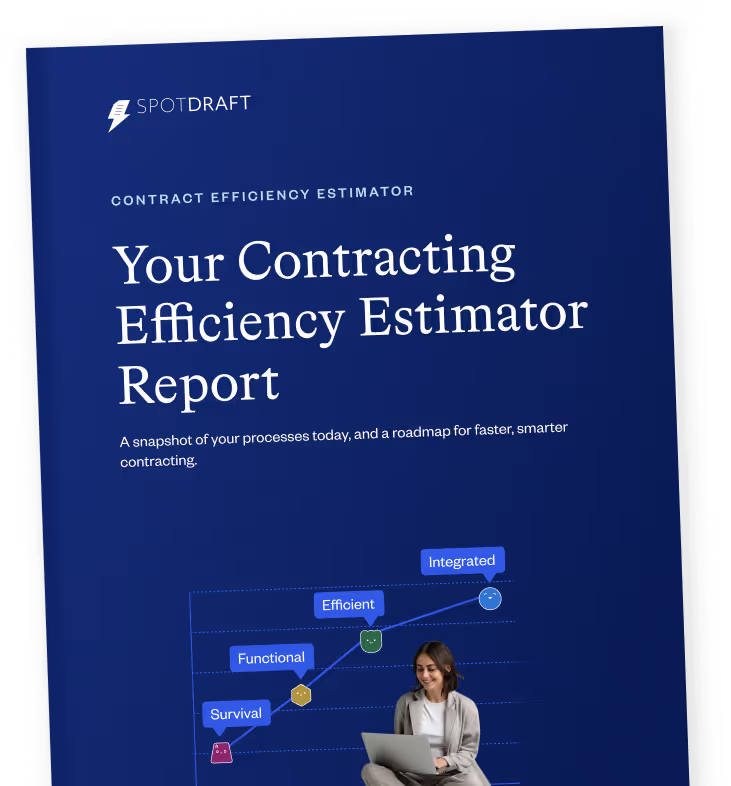Organizations with a robust contract management approach see 42% more renewals and 60% more renegotiation opportunities.
On the flip side, poor contract management processes are bleeding businesses dry, with studies showing up to a 9% loss in annual revenue across industries.
So, if you’ve been taking a laid-back approach to contract management, then you’re drastically underestimating the financial risks at play.
In this guide, we’ll discuss everything you’ll need to know about contract management and how you can transform it from a weak link into a competitive advantage.
What is contract management?
Contract management (also known as contract lifecycle management (CLM)) is the process of drafting, executing, storing, and monitoring legally binding agreements between two or more parties.
As a contract manager, your primary objective is to take charge of the entire contract lifecycle, tracking contract performance, managing renewals, and keeping everything on track so that business relationships stay on course.
Also read: Contract Lifecycle Management Process
The benefits of effective contract management
Effective contract lifecycle management is a non-negotiable in today's fiercely competitive business ecosystem. Top-performing companies get this and are constantly optimizing their approach for the best results.
If you take a step towards leveling up your contract management process, here are some benefits that may be in store for you:
#1 Cost savings
Contract management helps you keep more money in your pocket by highlighting cost-saving opportunities. This can be through negotiating better terms, removing unnecessary expenses, or simply streamlining renewals. That way, you’re not leaving money on the table anymore.
#2 Improved document accessibility
“Think about how many contracts sit on someone’s laptop or in multiple databases and then think about the value of contract management. The importance of simply being able to locate all of the company’s contracts and relevant amendments in one place without significant effort cannot be minimized.”
~ Sterling Miller, CEO and Senior Counsel, Hilgers Graben PLLC
Minimizing Risk in Commercial Contracts
No contract manager loves to search through piles of paperwork or endlessly click through scattered digital threads in search of contracts or contract data. A good contract management process saves everyone from that hassle, incorporating a storage system that supports accessibility.
With proper contract management, you’ll have everything you need at your fingertips, so you’re never caught scrambling to find the needle in the haystack when the time comes.
Also read: Tips to Store Your Contracts Effectively
#3 Long-term resilience
With contract management activities running smoothly, companies can focus on long-term business outcomes rather than constantly firefighting problems caused by poorly managed contracts.
A strong contract management system provides the structure and foresight needed to anticipate challenges, maintain compliance, and adapt to market changes.
This level of control builds stability and ensures that contract managers are well-positioned to drive business growth and stay resilient, even during tough times.
#4 Better risk management
”You can either be part of the cleanup crew or do stuff to avoid that cleanup situation altogether."
~Gitanjali Faleiro, GC, Company Secretary & CCO at Greenhill & Co.
Navigating the C-Suite as a GC
With a well-rounded contract management process, businesses are much better equipped to spot potential risks before they become full-blown issues.
Whether it’s compliance problems, financial risks, or legal loopholes, a proactive contract management strategy acts as an early-warning system, giving you a chance to nip things in the bud.
Also read: Legal Risk Management: From the Playbook of 11 GCs & Leaders
#5 Operational efficiency
According to a report by World Contracting and Commerce (WCC), approximately 32% of a company’s workforce is involved in contract management. When contracts are well-managed, everything runs more smoothly. People know what to expect, and there’s no confusion about who’s doing what and when.
A solid contract management approach means fewer bottlenecks, less back-and-forth, and more time spent on productive work rather than untangling a mess of missed deadlines, unclear terms, and accountability issues.

Also read: Why is contract management important?
Contract management process
Contract lifecycle management is broken into seven broad phases, including:
- Creation
- Review and approval
- Negotiation
- Execution
- Storage
- Performance monitoring
- Renewal (or, in some cases, termination)
These entire phases are further categorized into two main stages: pre-execution and post-execution.

Source: Ben Collins via LinkedIn
Pre-execution
The pre-execution phase of contract management is where all the groundwork is laid before a legal agreement is signed. It encompasses the following subphases:
- Contract creation: This is where you draft the initial terms and conditions of the contract, including every information that may be relevant to the business relationship.
- Contract review and approval: After the initial drafting, the contract is moved to key stakeholders for review and approval. Once they confirm the contract is accurate and legally sound, it moves on to the next stage.
- Negotiation: Here, the contracting parties begin a back-and-forth over the details of the contract. This stage offers a chance to hash out any points of contention, adjust terms, and come to a mutual agreement.
- Execution: Once all parties have reached an agreement, they can proceed with signing on the dotted lines. Beyond this point, it becomes legally binding and ready to be implemented.
Post-execution

Source: Sidra Siddique via Quora
Once the contract is signed and the ink is dry, we enter the post-execution phase of contract management. This phase focuses on ensuring that the terms are followed correctly and that all parties meet their contractual obligations.
It includes the following subphases:
- Storage: Once the agreement becomes legally binding, the first step, post-execution, is to store it in a secure contract repository. This can be a centralized storage system like SpotDraft, which keeps contract documents organized and safe. That way, no one will have to scramble when it's time to run through the contract again.
- Performance monitoring: This part involves keeping your eyes on contractual obligations, timelines, and overall contract performance to make sure everyone is holding up their end of the deal.
- Renewal or termination: As the contract’s term winds down, this stage is where you decide whether you want to pull the plug or extend the relationship. If things have gone well for both sides, a renewal might be the way to go.

Why you should ditch the manual contract management process
Contract management is a significantly routine process, and handling it manually can create more problems than it solves. Here are some of the key downsides you should be aware of:
#1 Human error
It’s easy to miss a deadline, skip over a key detail, or accidentally misplace a contract when you're managing everything by hand. This is because humans are prone to exhaustion, and it’s hard to stay sharp when you’re constantly battling mundane contract processes.
54% of legal professionals are constantly dealing with exhaustion due to excessive manual labor and limited resources. This mental fatigue can open the door to errors, which can snowball into big problems for your organization.
#2 Limited contract visibility

Source: Md Wasim Ahmad via LinkedIn
Imagine having your contracts scattered across email threads, filing cabinets, and random digital folders. To access files and contract data, you'll need to physically search your cabinets or request access from individuals.
This can get even worse if you work in an organization with branches in multiple locations.
With such a fragmented contract management system, getting quick insights about your contracts will be almost impossible.
#3 Security risks
Manual contract management typically involves storing contracts in physical cabinets or clunky digital systems.
This exposes contracts to unauthorized access, data breaches, damage, or loss.
#4 Scalability issues
Manual contract management at a small scale might seem manageable at first, but as your business grows, the workload can quickly become overwhelming. At this point, the risk of errors, missed deadlines, and lost contracts will grow exponentially.
#5 Financial losses
Manual contract management can hit your bottom line in more ways than one. Missed renewal dates, overlooked clauses, and penalties due to non-compliance can all result in unnecessary financial losses.
The lack of automated contract tracking means you might not catch these issues until it’s too late, leading to late fees, lost opportunities for renegotiation, unwanted auto-renewals, or even legal battles.

Source: Renie Fernandes via LinkedIn
.avif)
Best practices for successful contract management
The goal of every contract manager is ultimately the same: to help increase revenue, minimize business risks, and reduce costs. These are all within reach, but your contract management approach will always play a huge role in getting there. Here are some best practices to follow:
#1 Automate the routine
Contract management is about making your own contracts work for you, not against you. When you’re too busy manually handling routine processes, you’ll end up dragging your company several steps behind its competition.
Using robust contract management software, automate every routine process in contract creation, review, approval, and reporting. This will free up time to accomplish more in your day-to-day.
#2 Centralize your entire contract portfolio
Centralizing your business contracts and everything related can save you from unnecessary hassle when you need to access them.
Prioritize a robust, secure, and searchable contract repository so that only the right stakeholders can access the contracts at any given time. And when they need to do that, they can locate what they need in just a few clicks, regardless of the time or location.
#3 Empower cross-functional teams to be independent

Source: Craig Conte via LinkedIn
Contract management often touches multiple teams—legal, sales, procurement, finance, and beyond. If every minor update or clarification requires running back to legal, then you won’t be able to scale as fast as you should.
Equip your teams with simple, pre-approved templates, playbooks, checklists, and other contract management tools they can use for standard, routine contracts. That way, they can make effective decisions without running everything through legal.
“The absence of contract templates leads to non-standardisation and makes contracts prone to errors. The legal team, therefore, is required to delve deep into contracts and proofread all clauses with a fine-tooth comb to identify and rectify the simplest of human errors.”
~Igor Poroger, Director of Legal, EMEA, Vectra AI
The Counsel Corner: How CLMs Empower Legal Teams in B2B SaaS Companies
#4 Assign ownerships to critical phases for accountability
Imagine an important renewal date is around the corner, and everyone assumes someone else is handling it. What are the chances your current supplier won’t lock you into unfavorable terms for another year?
To avoid this situation, put stakeholders in charge of every critical phase of the contract lifecycle—contract negotiation, review, performance tracking, review, etc.
When everyone knows exactly what’s on their plate, there’ll be no room for “I thought you had it.”
#5 Prioritize CLM software that integrates with your existing tech stack
“Leveraging a CLM has been key because it has reduced a lot of friction from handoffs between legal and business. Rather than going back and forth over email, Slack, Word, Zoom, DocuSign, and a whole tech stack, the CLM acts as a single source of truth.”
~Jonathan Franz, Head of Legal, Crunchbase
Navigating Economic Turbulence and Thriving in Chaos
Contract Lifecycle Management (CLM) tools are designed to help you manage contracts more efficiently. But they’re not all equal in terms of usefulness, cost-effectiveness, and alignment with unique organizational needs.
When implementing Contract Lifecycle Management software, prioritize solutions that seamlessly integrate with platforms your team already uses, like CRM, ERP, or collaboration tools.
When everything works together, data flows smoothly, and you avoid the chaos of jumping between systems or manually transferring information.
Supercharge your contract management with AI

Source: Craig Conte via LinkedIn
More companies are ramping up their efforts to incorporate AI-powered tools into contract management processes. In a study by LexisNexis, 82% of legal teams are currently using AI for processes like contract review, drafting, analytics, and more.
This has allowed them to close deals significantly faster and manage contracts more efficiently.
If you're looking to transform your company's contract management strategy with the latest technological revolution, you need a platform that's robust enough to automate and scale your workflows yet sufficiently intuitive for smooth adoption by your team.
This is where SpotDraft comes in. SpotDraft is an AI-powered CLM designed to eliminate all the headaches associated with contract management. Built on a model-agnostic architecture, SpotDraft leverages the latest AI technology to enhance productivity and minimize risks at all stages of the contract lifecycle.
Ready to ditch the mind-numbing work? Click here to get a demo tailored specifically for your organization!









